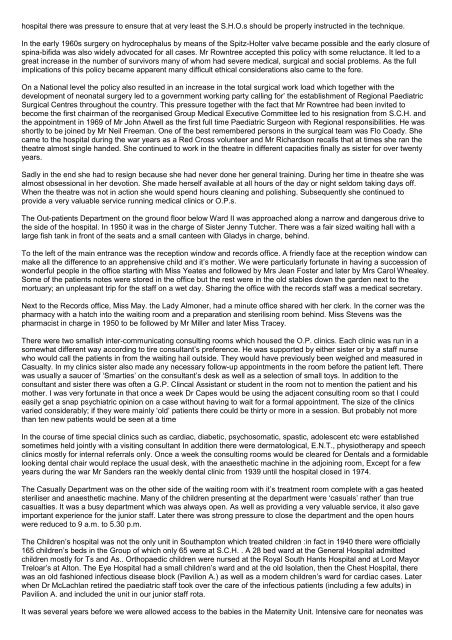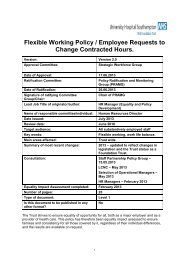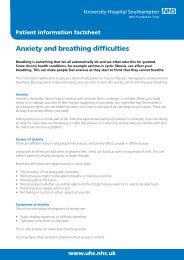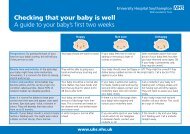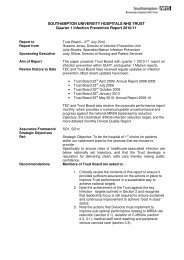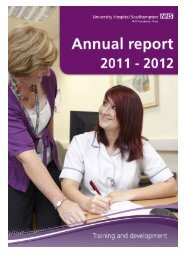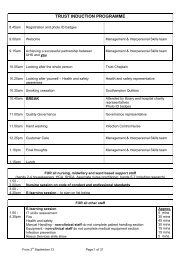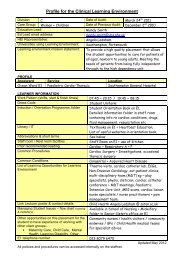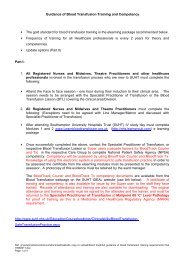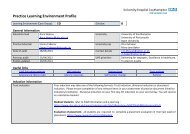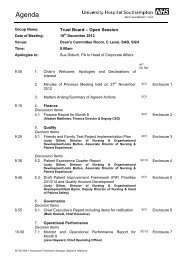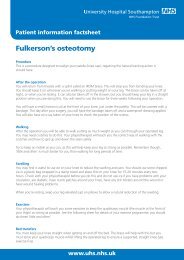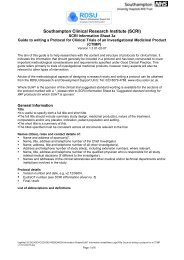ninety years of service - University Hospital Southampton NHS ...
ninety years of service - University Hospital Southampton NHS ...
ninety years of service - University Hospital Southampton NHS ...
- No tags were found...
Create successful ePaper yourself
Turn your PDF publications into a flip-book with our unique Google optimized e-Paper software.
hospital there was pressure to ensure that at very least the S.H.O.s should be properly instructed in the technique.In the early 1960s surgery on hydrocephalus by means <strong>of</strong> the Spitz-Holter valve became possible and the early closure <strong>of</strong>spina-bifida was also widely advocated for all cases. Mr Rowntree accepted this policy with some reluctance. It led to agreat increase in the number <strong>of</strong> survivors many <strong>of</strong> whom had severe medical, surgical and social problems. As the fullimplications <strong>of</strong> this policy became apparent many difficult ethical considerations also came to the fore.On a National level the policy also resulted in an increase in the total surgical work load which together with thedevelopment <strong>of</strong> neonatal surgery led to a government working party calling for’ the establishment <strong>of</strong> Regional PaediatricSurgical Centres throughout the country. This pressure together with the fact that Mr Rowntree had been invited tobecome the first chairman <strong>of</strong> the reorganised Group Medical Executive Committee led to his resignation from S.C.H. andthe appointment in 1969 <strong>of</strong> Mr John Atwell as the first full time Paediatric Surgeon with Regional responsibilities. He wasshortly to be joined by Mr Neil Freeman. One <strong>of</strong> the best remembered persons in the surgical team was Flo Coady. Shecame to the hospital during the war <strong>years</strong> as a Red Cross volunteer and Mr Richardson recalls that at times she ran thetheatre almost single handed. She continued to work in the theatre in different capacities finally as sister for over twenty<strong>years</strong>.Sadly in the end she had to resign because she had never done her general training. During her time in theatre she wasalmost obsessional in her devotion. She made herself available at all hours <strong>of</strong> the day or night seldom taking days <strong>of</strong>f.When the theatre was not in action she would spend hours cleaning and polishing. Subsequently she continued toprovide a very valuable <strong>service</strong> running medical clinics or O.P.s.The Out-patients Department on the ground floor below Ward II was approached along a narrow and dangerous drive tothe side <strong>of</strong> the hospital. In 1950 it was in the charge <strong>of</strong> Sister Jenny Tutcher. There was a fair sized waiting hall with alarge fish tank in front <strong>of</strong> the seats and a small canteen with Gladys in charge, behind.To the left <strong>of</strong> the main entrance was the reception window and records <strong>of</strong>fice. A friendly face at the reception window canmake all the difference to an apprehensive child and it’s mother. We were particularly fortunate in having a succession <strong>of</strong>wonderful people in the <strong>of</strong>fice starting with Miss Yeates and followed by Mrs Jean Foster and later by Mrs Carol Whealey.Some <strong>of</strong> the patients notes were stored in the <strong>of</strong>fice but the rest were in the old stables down the garden next to themortuary; an unpleasant trip for the staff on a wet day. Sharing the <strong>of</strong>fice with the records staff was a medical secretary.Next to the Records <strong>of</strong>fice, Miss May. the Lady Almoner, had a minute <strong>of</strong>fice shared with her clerk. In the corner was thepharmacy with a hatch into the waiting room and a preparation and sterilising room behind. Miss Stevens was thepharmacist in charge in 1950 to be followed by Mr Miller and later Miss Tracey.There were two smallish inter-communicating consulting rooms which housed the O.P. clinics. Each clinic was run in asomewhat different way according to tire consultant’s preference. He was supported by either sister or by a staff nursewho would call the patients in from the waiting hail outside. They would have previously been weighed and measured inCasualty. In my clinics sister also made any necessary follow-up appointments in the room before the patient left. Therewas usually a saucer <strong>of</strong> ‘Smarties’ on the consultant’s desk as well as a selection <strong>of</strong> small toys. In addition to theconsultant and sister there was <strong>of</strong>ten a G.P. Clincal Assistant or student in the room not to mention the patient and hismother. I was very fortunate in that once a week Dr Capes would be using the adjacent consulting room so that I couldeasily get a snap psychiatric opinion on a case without having to wait for a formal appointment. The size <strong>of</strong> the clinicsvaried considerably; if they were mainly ‘old’ patients there could be thirty or more in a session. But probably not morethan ten new patients would be seen at a timeIn the course <strong>of</strong> time special clinics such as cardiac, diabetic, psychosomatic, spastic, adolescent etc were establishedsometimes held jointly with a visiting consultant In addition there were dermatological, E.N.T., physiotherapy and speechclinics mostly for internal referrals only. Once a week the consulting rooms would be cleared for Dentals and a formidablelooking dental chair would replace the usual desk, with the anaesthetic machine in the adjoining room, Except for a few<strong>years</strong> during the war Mr Sanders ran the weekly dental clinic from 1939 until the hospital closed in 1974.The Casually Department was on the other side <strong>of</strong> the waiting room with it’s treatment room complete with a gas heatedsteriliser and anaesthetic machine. Many <strong>of</strong> the children presenting at the department were ‘casuals’ rather’ than truecasualties. It was a busy department which was always open. As well as providing a very valuable <strong>service</strong>, it also gaveimportant experience for the junior staff. Later there was strong pressure to close the department and the open hourswere reduced to 9 a.m. to 5.30 p.m.The Children’s hospital was not the only unit in <strong>Southampton</strong> which treated children :in fact in 1940 there were <strong>of</strong>ficially165 children’s beds in the Group <strong>of</strong> which only 65 were at S.C.H. . A 28 bed ward at the General <strong>Hospital</strong> admittedchildren mostly for Ts and As.. Orthopaedic children were nursed at the Royal South Hants <strong>Hospital</strong> and at Lord MayorTreloar’s at Alton. The Eye <strong>Hospital</strong> had a small children’s ward and at the old Isolation, then the Chest <strong>Hospital</strong>, therewas an old fashioned infectious disease block (Pavilion A.) as well as a modern children’s ward for cardiac cases. Laterwhen Dr McLachlan retired the paediatric staff took over the care <strong>of</strong> the infectious patients (including a few adults) inPavilion A. and included the unit in our junior staff rota.It was several <strong>years</strong> before we were allowed access to the babies in the Maternity Unit. Intensive care for neonates was


